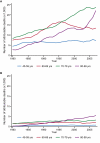Adult mortality attributable to preventable risk factors for non-communicable diseases and injuries in Japan: a comparative risk assessment
- PMID: 22291576
- PMCID: PMC3265534
- DOI: 10.1371/journal.pmed.1001160
Adult mortality attributable to preventable risk factors for non-communicable diseases and injuries in Japan: a comparative risk assessment
Abstract
Background: The population of Japan has achieved the longest life expectancy in the world. To further improve population health, consistent and comparative evidence on mortality attributable to preventable risk factors is necessary for setting priorities for health policies and programs. Although several past studies have quantified the impact of individual risk factors in Japan, to our knowledge no study has assessed and compared the effects of multiple modifiable risk factors for non-communicable diseases and injuries using a standard framework. We estimated the effects of 16 risk factors on cause-specific deaths and life expectancy in Japan.
Methods and findings: We obtained data on risk factor exposures from the National Health and Nutrition Survey and epidemiological studies, data on the number of cause-specific deaths from vital records adjusted for ill-defined codes, and data on relative risks from epidemiological studies and meta-analyses. We applied a comparative risk assessment framework to estimate effects of excess risks on deaths and life expectancy at age 40 y. In 2007, tobacco smoking and high blood pressure accounted for 129,000 deaths (95% CI: 115,000-154,000) and 104,000 deaths (95% CI: 86,000-119,000), respectively, followed by physical inactivity (52,000 deaths, 95% CI: 47,000-58,000), high blood glucose (34,000 deaths, 95% CI: 26,000-43,000), high dietary salt intake (34,000 deaths, 95% CI: 27,000-39,000), and alcohol use (31,000 deaths, 95% CI: 28,000-35,000). In recent decades, cancer mortality attributable to tobacco smoking has increased in the elderly, while stroke mortality attributable to high blood pressure has declined. Life expectancy at age 40 y in 2007 would have been extended by 1.4 y for both sexes (men, 95% CI: 1.3-1.6; women, 95% CI: 1.2-1.7) if exposures to multiple cardiovascular risk factors had been reduced to their optimal levels as determined by a theoretical-minimum-risk exposure distribution.
Conclusions: Tobacco smoking and high blood pressure are the two major risk factors for adult mortality from non-communicable diseases and injuries in Japan. There is a large potential population health gain if multiple risk factors are jointly controlled.
Conflict of interest statement
The authors have declared that no competing interests exist.
Figures



References
-
- World Health Organization. Disease and injury regional estimates. 2011. Cause-specific mortaliy: regional estimates for 2008. Available: http://www.who.int/healthinfo/global_burden_disease/estimates_regional/e.... Accessed 20 December 2011.
-
- World Health Organization. Global health risks: mortality and burden of disease attributable to selected major risks. Geneva: World Health Organization; 2009.
-
- Ministry of Health, Labour and Welfare. Abridged life tables for Japan 2009. Tokyo: Ministry of Health, Labour and Welfare; 2010.
-
- Ikeda N, Saito E, Kondo N, Inoue M, Ikeda S, et al. What has made the population of Japan healthy? Lancet. 2011;378:1094–1105. - PubMed
-
- Ministry of Health, Labour and Welfare. Vital statistics. 2011. Available: http://www.mhlw.go.jp/english/database/db-hw/index.html. Accessed 5 July 2011.
Publication types
MeSH terms
LinkOut - more resources
Full Text Sources
Medical
Miscellaneous

